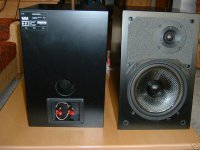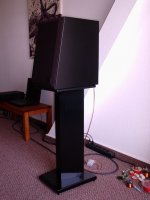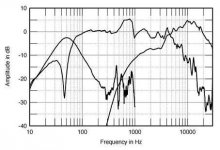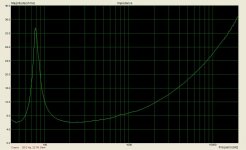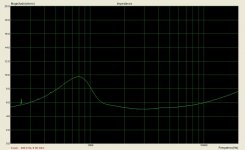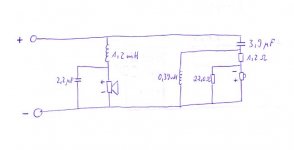Hi!
I'm in the middle of a progress here, designing a 2-way crossover for a 8" midbass and a 1" soft dome tweeter, only by listening (no measurement equipment at hands, unfortunately). I'm observing a strange phenomenon here: Some crossover designs call for a reversed polarity of the tweeter. Otherwise I get a deep notch in the x-over region and I can clearly tell which part of the signal comes from the woofer and which comes from the tweeter, as it should be. With reversed polarity of the tweeter everything falls into place, the mids are open, clear and the whole 2-way speaker sounds like one single fullrange driver.
So far, so well - but: Whenever I do this and I listen to some music for a longer time period I find something I dislike. Hard to explain, but when the polarity is reversed, despite of a great midrange and smooth blending of both drivers in the x-over region, I find the sound somehow, well, "greyish", particularly in the upper mids and the highs in general. That's strange and as said, very hard to explain, but I think the tweeter itself sounds different when connected reversed, which obviously seems to be not the case with many commercial or non-commercial designs where the tweeters are often connected reversed.
In my case it's a rather old Vifa D27TG-46-06, which sounds completely fine when connected with the same polarity as the midwoofer.
Does anyone have a clue how this could be explained?
Thanks a lot!
Martin
I'm in the middle of a progress here, designing a 2-way crossover for a 8" midbass and a 1" soft dome tweeter, only by listening (no measurement equipment at hands, unfortunately). I'm observing a strange phenomenon here: Some crossover designs call for a reversed polarity of the tweeter. Otherwise I get a deep notch in the x-over region and I can clearly tell which part of the signal comes from the woofer and which comes from the tweeter, as it should be. With reversed polarity of the tweeter everything falls into place, the mids are open, clear and the whole 2-way speaker sounds like one single fullrange driver.
So far, so well - but: Whenever I do this and I listen to some music for a longer time period I find something I dislike. Hard to explain, but when the polarity is reversed, despite of a great midrange and smooth blending of both drivers in the x-over region, I find the sound somehow, well, "greyish", particularly in the upper mids and the highs in general. That's strange and as said, very hard to explain, but I think the tweeter itself sounds different when connected reversed, which obviously seems to be not the case with many commercial or non-commercial designs where the tweeters are often connected reversed.
In my case it's a rather old Vifa D27TG-46-06, which sounds completely fine when connected with the same polarity as the midwoofer.
Does anyone have a clue how this could be explained?
Thanks a lot!
Martin
Last edited:
The lack of measurement equipment means you'll only be stabbing in the dark as to 'why' this could be happening. While it is true that with even order xovers, wiring one of the drivers out of phase to how it should normally be wired, should create a deep suckout, this relies heavily on the fact that you're crossover has been designed adequately in the first place. Often it takes a lot of fiddling about with asymmetrical slopes to actually get the drivers to be in phase in the first place.
If you've managed to arrive at a flat response with good phase tracking throughout the xover region without measuring anything then I would be quite surprised. With a less then perfect crossover reversing the tweeter polarity wont give you a noticeable notch whatever way you wire it, however altering the polarity will alter the frequency response, often putting lumps and bumps in different places and thus giving you a different presentation of sound.
If you've managed to arrive at a flat response with good phase tracking throughout the xover region without measuring anything then I would be quite surprised. With a less then perfect crossover reversing the tweeter polarity wont give you a noticeable notch whatever way you wire it, however altering the polarity will alter the frequency response, often putting lumps and bumps in different places and thus giving you a different presentation of sound.
Not surprised with a 8" 2 way , very difficult to get right even for the pro's. It takes a special mid-bass driver and low cross point in most cases.
publish your circuit and box alignment, nearfield applications can help some.
I'd venture to guess crossing lower with a 3rd order high pass section will give better listening.
publish your circuit and box alignment, nearfield applications can help some.
I'd venture to guess crossing lower with a 3rd order high pass section will give better listening.
Last edited:
reverse polarity tweeter connection
In particular if a 3rd order x-over is employed, reversing the polarity to the tweeter ccan help reduce a phase "tilt", regardless of the physical design of the enclosure (with "time aligned" offset or not).
A picture of your enclosure and the x-over circuit might help this. I suspect the "greying" of the sound may be due to this tilt, and any offset of the drivers in the horisontal plain.
You might have a look here to gain a little insight.
One of the first pieces of equipment that I had reviewed were a pair of loudspeakers that suffered from this same issue. All high quality parts were there (including Solen caps, good circuit board, good drivers and enclosures) but there was something very "odd" about the sound. They seemed very "spacey" (for lack of a better descriptor). I contacted the manufacturer, who said they usd an aysymetric cross over (3rd order on tweeter, 2nd order on mid/bass). After some thought and recalling I had read in the Loudspeaker Design Cookbook (by Lance Dickenson) that there can be phase issues with tweeters using a 3rd order x-over, I decided to wire the tweeters out of phase. Instantly the sound became excellent. These loudspeakers were a typical rectangular box, with no "time alignment" sloping baffle or anything of the sort.
In particular if a 3rd order x-over is employed, reversing the polarity to the tweeter ccan help reduce a phase "tilt", regardless of the physical design of the enclosure (with "time aligned" offset or not).
A picture of your enclosure and the x-over circuit might help this. I suspect the "greying" of the sound may be due to this tilt, and any offset of the drivers in the horisontal plain.
You might have a look here to gain a little insight.
One of the first pieces of equipment that I had reviewed were a pair of loudspeakers that suffered from this same issue. All high quality parts were there (including Solen caps, good circuit board, good drivers and enclosures) but there was something very "odd" about the sound. They seemed very "spacey" (for lack of a better descriptor). I contacted the manufacturer, who said they usd an aysymetric cross over (3rd order on tweeter, 2nd order on mid/bass). After some thought and recalling I had read in the Loudspeaker Design Cookbook (by Lance Dickenson) that there can be phase issues with tweeters using a 3rd order x-over, I decided to wire the tweeters out of phase. Instantly the sound became excellent. These loudspeakers were a typical rectangular box, with no "time alignment" sloping baffle or anything of the sort.
Last edited:
First of all: Thanks a lot for your replies!
Ok, here goes...
The speaker is from Reference 3a, a very early incarnation of the current model De Capo i:
Reference 3A Loudspeakers
The main driver is a hand made 8" carbon fibre midwoofer with stiff membrane and a large magnet, designed to not require any crossover at all. The tweeter in my early version is the Vifa D27TG-06-35 (I switched to the D27TG-06-46 because of a slightly softer sound), and it's crossed over just by a single 4,7uF cap and a zobel for impedance linearisation (22uF & 15R0). The enclosure is about 22l ported.
Here are some pics of my speakers. As you can see, the front baffle is slightly sloped to physically time align the drivers (at least to a certain degree).
Ok, here goes...
The speaker is from Reference 3a, a very early incarnation of the current model De Capo i:
Reference 3A Loudspeakers
The main driver is a hand made 8" carbon fibre midwoofer with stiff membrane and a large magnet, designed to not require any crossover at all. The tweeter in my early version is the Vifa D27TG-06-35 (I switched to the D27TG-06-46 because of a slightly softer sound), and it's crossed over just by a single 4,7uF cap and a zobel for impedance linearisation (22uF & 15R0). The enclosure is about 22l ported.
Here are some pics of my speakers. As you can see, the front baffle is slightly sloped to physically time align the drivers (at least to a certain degree).
Attachments
Now, what I think is that, at least in this old model, the midwoofer does have some resonances, and while the sound is incredibly open and fast, with some recordings the upper mids are a bit too excessive. That's why I decided to design a simple crossover, to "calm 'em down a bit".
Here is a measuring plot of the direct successor (MM De Capo, no x-over on woofer, single 5uF cap on tweeter), tweeter and woofer measured separately:
Here is a measuring plot of the direct successor (MM De Capo, no x-over on woofer, single 5uF cap on tweeter), tweeter and woofer measured separately:
Attachments
Last edited:
I know, it's not exactly what you guys are used to, but the sound definitely has something to it!
I wanted to just smooth out the upper mids a bit, so I went for a single 0,47mH inductor and the 4,7uF cap for the tweeter, without the zobel. While the result is quite good and listenable with most recordings, on some recordings I felt there could be done more. So I measured impedance plots of both drivers, calculated a bit and tried serveral reasonable crossover variants, 6dB/6dB, with and without zobel for tweeter/woofer, 6dB on woofer, 12dB on tweeter and finally 12dB/12dB, with reversed polarity on the tweeter. Due to the smooth and extended response of the woofer and because I really like the sound of higher crossed midwoofers better, the crossover frequency was always chosen within the range of 3,5kHz up to 5,5kHz.
Pics of the impedance plots (measured with ARTA):
I wanted to just smooth out the upper mids a bit, so I went for a single 0,47mH inductor and the 4,7uF cap for the tweeter, without the zobel. While the result is quite good and listenable with most recordings, on some recordings I felt there could be done more. So I measured impedance plots of both drivers, calculated a bit and tried serveral reasonable crossover variants, 6dB/6dB, with and without zobel for tweeter/woofer, 6dB on woofer, 12dB on tweeter and finally 12dB/12dB, with reversed polarity on the tweeter. Due to the smooth and extended response of the woofer and because I really like the sound of higher crossed midwoofers better, the crossover frequency was always chosen within the range of 3,5kHz up to 5,5kHz.
Pics of the impedance plots (measured with ARTA):
Attachments
I'd need better specs on the woofer, the response curves w/o any data from the OLD baffle used, shows nasty peak below 1KHz followed by sharp dip. either way I don't think any reasonable 2 way Xover is the answer to that. Maybe if you like the wide open sound of the woofer by itself using a helper horn loaded tweeter crossed at 6K- ish would be one simple answer to help match directivity up there. other more complex Xover circuits would need more precision measurements.
so in effect going back to BSC inductor on the woofer and 1st order on a new HORN tweeter.
so in effect going back to BSC inductor on the woofer and 1st order on a new HORN tweeter.
Last edited:
The woofer looks to an Audax HM210C0 surround reversed.
http://www.audax.com/archives/HM210C0 - Catalogue 1994.pdf
I recommend to try a 6dB on the woofer and 12dB on the tweeter.
Edit :
Same polarity of the drivers
Woofer L=1mH Tweeter values recommended by Vifa C=8.2u L=0.47mH.
http://www.audax.com/archives/HM210C0 - Catalogue 1994.pdf
I recommend to try a 6dB on the woofer and 12dB on the tweeter.
Edit :
Same polarity of the drivers
Woofer L=1mH Tweeter values recommended by Vifa C=8.2u L=0.47mH.
Last edited:
3a MM...
I dug out an old review of these....
Apparently the tweeter is a Phillips one, unless 3a changed it during production (the review was from 1990).
Here are a couple of recommendations that are based with general experiences and not specific to 3a:
the mid/bass: If the woofer resonates, try tightening the screws or use hex headed thread inserts and the corresponding correct screws. You can also take some time and dampen the mid/bass frame, etc. If wanting to improve the sound and control the woofer a little more, you might try stuffing a bundle of drinking straws into the port(tightly). This may or may not help, but it is a very cheap fix if it works, is easy to do and is completely reversible. You can also add a support from the rear of the cabinet to the back of the driver that puts some force on the magnet.
the tweeter: Not every tweeter can be used at a low frequency. Get an exact replacement or seek technical advice from 3a, and ask for a recomendation if the old tweeter is not available. It may look like a Vifa (and in the pictures within the old review the tweeters do look like Vifa), but check with 3a, based on your serial numbers.
Apparently there is no x-over to the mid/bass drivers and only a cap to help keep the tweeter intact.
Please do not take this as an attack: the problems you are having could well be attributed to taking something that works brilliantly due to its simplicity, and complicating it enough to ruin the work of the speaker designer. If you want to work at getting a new cross-over developed, I would start with the purchase of a Behringer DCX2496 or mini-dsp electronic crossover. Then add whatever mikes and measurement system and go from there. The true "art" of loudspeaker design is in the cross-over (I think) and is often minimized by some of us "DIY types".
I dug out an old review of these....
Apparently the tweeter is a Phillips one, unless 3a changed it during production (the review was from 1990).
Here are a couple of recommendations that are based with general experiences and not specific to 3a:
the mid/bass: If the woofer resonates, try tightening the screws or use hex headed thread inserts and the corresponding correct screws. You can also take some time and dampen the mid/bass frame, etc. If wanting to improve the sound and control the woofer a little more, you might try stuffing a bundle of drinking straws into the port(tightly). This may or may not help, but it is a very cheap fix if it works, is easy to do and is completely reversible. You can also add a support from the rear of the cabinet to the back of the driver that puts some force on the magnet.
the tweeter: Not every tweeter can be used at a low frequency. Get an exact replacement or seek technical advice from 3a, and ask for a recomendation if the old tweeter is not available. It may look like a Vifa (and in the pictures within the old review the tweeters do look like Vifa), but check with 3a, based on your serial numbers.
Apparently there is no x-over to the mid/bass drivers and only a cap to help keep the tweeter intact.
Please do not take this as an attack: the problems you are having could well be attributed to taking something that works brilliantly due to its simplicity, and complicating it enough to ruin the work of the speaker designer. If you want to work at getting a new cross-over developed, I would start with the purchase of a Behringer DCX2496 or mini-dsp electronic crossover. Then add whatever mikes and measurement system and go from there. The true "art" of loudspeaker design is in the cross-over (I think) and is often minimized by some of us "DIY types".
Last edited:
There are couple of well respected online guys doing work with normal 1"dome tweeters and DIY horns. I don't have the direct links handy but they are Zaph (John) and a guy in Denmark AFAIK. hopefully others can chime in.
In my opinion the original filterless loudspeaker is an accident waiting to happen. Zero baffle-step compensation...resonances running wild.. then again to each their own.
As infinia says a special mid/bass is often required, usually a well damped poly or paper cone to keep the high end breakup as well controlled as possible.
The peak/dip combo around 1000hz will be from diffraction, but also probably a resonance somewhere in the driver itself. In the impedance sweep you've made there is clearly something going on @ 800hz. On its own this would likely be not much of an issue, but the resonance combined with the diffraction peak/dip is probably what's created the large peak as shown in the stereophile review.
What order filters are required depends heavily on what drive units are used. In an end loudspeaker you are looking at end game acoustic slopes. That is the drivers natural acoustic roll off combined with the electrical characteristics of the crossover.
The Vifa is probably good down to around 2khz if a steep acoustic slope is the target and the 8" mid/bass would certainly prefer being crossed over lower then higher. The trouble with a design like this is you are pushing both drivers to the limit of their acceptable range of operation, this tends to require a very well designed crossover too because the drivers own roll off is heavily factored into the equation.
That being said any decent stab at a passive xover that attempts to include baffle step compensation and control the upper end of the 8" mid/bass should sound far better then letting it run full range.
As infinia says a special mid/bass is often required, usually a well damped poly or paper cone to keep the high end breakup as well controlled as possible.
The peak/dip combo around 1000hz will be from diffraction, but also probably a resonance somewhere in the driver itself. In the impedance sweep you've made there is clearly something going on @ 800hz. On its own this would likely be not much of an issue, but the resonance combined with the diffraction peak/dip is probably what's created the large peak as shown in the stereophile review.
What order filters are required depends heavily on what drive units are used. In an end loudspeaker you are looking at end game acoustic slopes. That is the drivers natural acoustic roll off combined with the electrical characteristics of the crossover.
The Vifa is probably good down to around 2khz if a steep acoustic slope is the target and the 8" mid/bass would certainly prefer being crossed over lower then higher. The trouble with a design like this is you are pushing both drivers to the limit of their acceptable range of operation, this tends to require a very well designed crossover too because the drivers own roll off is heavily factored into the equation.
That being said any decent stab at a passive xover that attempts to include baffle step compensation and control the upper end of the 8" mid/bass should sound far better then letting it run full range.
The name of the game is matching gain, phase and directivity's between drive units.
using a large 8" diapham woofer and flat flanged domes with wide directivity means lower Xover frequency and high order topology. With a horn tweeter (boosting the tweeters LF gain) you can cross higher with a simple series HPF resulting in a net flat response and also choosing the Xover frequency where the 2 drivers off axis responses match. I would select a Morel horn or a lower cost Vifa like this one Vifa BC25SC06-04 and experiment with L padding and a series cap. Like 5th E. says don't omit a series L BSC inductor for the midbass. Horn response is key to all this discussion falling HF response at off axis ie grey tone. easier to solve w/ nearfield apps.
using a large 8" diapham woofer and flat flanged domes with wide directivity means lower Xover frequency and high order topology. With a horn tweeter (boosting the tweeters LF gain) you can cross higher with a simple series HPF resulting in a net flat response and also choosing the Xover frequency where the 2 drivers off axis responses match. I would select a Morel horn or a lower cost Vifa like this one Vifa BC25SC06-04 and experiment with L padding and a series cap. Like 5th E. says don't omit a series L BSC inductor for the midbass. Horn response is key to all this discussion falling HF response at off axis ie grey tone. easier to solve w/ nearfield apps.
Hmmm...
A few things to mention:
- The attempt of the original version of this speaker was/is more of a "fullrange-with-super-tweeter"-nature. The carbon fibre cone of the midwoofer is light and stiff, like the cones of many fullrange drivers (with paper cones, for example).
- The oddly shaped peak around 800 to 1000Hz looks quite unusual, but it doesn't sound as bad as it looks. Somehow this peak gives the speaker its very own signature.
- As for the BSC, there is no need for that. The graph from the stereophile review is a measurement of the drivers in the box, not on an infinite baffle. There is no rise in output power towards mid or high frequencies with this woofer. Whenever I put a rather large coil in series, say, 1,2mH up to 1,8mH, the mids appear to be heavily dampend. As a result, the speaker sounds dull and very closed in. To cross the tweeter lower to fill that gap results in a typical, ordinary "2-way-bookshelf-sound", meaning that all of the openness and transparency of the midrange is gone, as well as the big image these speakers can produce.
I know, this is an unusual speaker design. But the heart of this speaker really beats in the midrange. With this woofer the midrange sounds fast, clean, accurate, organic and open. Up to around 4kHz it really is usable. The problem is in the region from 4kHz to 7kHz, where the midwoofer has to pass out steep enough to prevent its cone breakup resonances from coming through too much, but at the same time flat enough to blend midwoofer and tweeter in smoothly.
Not an easy task, especially without measuring equipment. I had quite good results with the filter below: Midrange is clear and very open, resonances of cone breakup almost inaudible, tweeter blends in very nicely, the whole system sounds like one single fullrange driver, with just the right amount of "pling" in the highs and a nicely extended bottom end. It is supposed to be something like a 12dB/12dB Linkwitz-Riley, assuming 12R0 for woofer, 6R0 for tweeter and around 4000Hz as crossover frequency. Problem is, the tweeter polarity has to be reversed, otherwise there is a clear dip between woofer and tweeter. But with reversed polarity, I have this odd feeling of a less colorful presentation. The sound of this "pling" in the high end region just seems to be a bit "greyed out"...
And this is where my first post comes in again.
Sorry, I'm a tough customer...
A few things to mention:
- The attempt of the original version of this speaker was/is more of a "fullrange-with-super-tweeter"-nature. The carbon fibre cone of the midwoofer is light and stiff, like the cones of many fullrange drivers (with paper cones, for example).
- The oddly shaped peak around 800 to 1000Hz looks quite unusual, but it doesn't sound as bad as it looks. Somehow this peak gives the speaker its very own signature.
- As for the BSC, there is no need for that. The graph from the stereophile review is a measurement of the drivers in the box, not on an infinite baffle. There is no rise in output power towards mid or high frequencies with this woofer. Whenever I put a rather large coil in series, say, 1,2mH up to 1,8mH, the mids appear to be heavily dampend. As a result, the speaker sounds dull and very closed in. To cross the tweeter lower to fill that gap results in a typical, ordinary "2-way-bookshelf-sound", meaning that all of the openness and transparency of the midrange is gone, as well as the big image these speakers can produce.
I know, this is an unusual speaker design. But the heart of this speaker really beats in the midrange. With this woofer the midrange sounds fast, clean, accurate, organic and open. Up to around 4kHz it really is usable. The problem is in the region from 4kHz to 7kHz, where the midwoofer has to pass out steep enough to prevent its cone breakup resonances from coming through too much, but at the same time flat enough to blend midwoofer and tweeter in smoothly.
Not an easy task, especially without measuring equipment. I had quite good results with the filter below: Midrange is clear and very open, resonances of cone breakup almost inaudible, tweeter blends in very nicely, the whole system sounds like one single fullrange driver, with just the right amount of "pling" in the highs and a nicely extended bottom end. It is supposed to be something like a 12dB/12dB Linkwitz-Riley, assuming 12R0 for woofer, 6R0 for tweeter and around 4000Hz as crossover frequency. Problem is, the tweeter polarity has to be reversed, otherwise there is a clear dip between woofer and tweeter. But with reversed polarity, I have this odd feeling of a less colorful presentation. The sound of this "pling" in the high end region just seems to be a bit "greyed out"...
And this is where my first post comes in again.
Sorry, I'm a tough customer...
Attachments
Last edited:
Infinia,
do you mean something like this:
hifisound eShop*-*MOREL CAT-378 ACUFLEX*
Or, what about this one:
http://www.seas.no/index.php?option=com_content&task=view&id=184&Itemid=179
do you mean something like this:
hifisound eShop*-*MOREL CAT-378 ACUFLEX*
Or, what about this one:
http://www.seas.no/index.php?option=com_content&task=view&id=184&Itemid=179
Last edited:
funny you now start giving the circuit details.
my last post above yours and looking at the original design, should give you direction to proceed. ditch the 2nd order, BTW yes there is BSC built in the circuit shown.
my last post above yours and looking at the original design, should give you direction to proceed. ditch the 2nd order, BTW yes there is BSC built in the circuit shown.
Well, I wouldn't call this my "secret circuit". It's just one possibility. As for the BSC, I can also use 0,82mH and 3,9uF for the woofer, still good results, but phase integration seems to be not that good. With filters going towards Butterworth characteristic it doesn't matter that much how the tweeter is connected, the results are always inferior to the LR alignment.
I like the Morel . The SEAS make me nervous with a high Q response like that, The nature of multitone IMD puts junk back in-band!
I like the Morel, too, but unfortunately it seems to be only available with 94mm front plate diameter, and that's where I would get into trouble with mounting the drivers. My tweeters are 104mm diameter, flush mounted.
That's bad...
That's bad...
- Status
- Not open for further replies.
- Home
- Loudspeakers
- Multi-Way
- Reversed tweeter polarity
